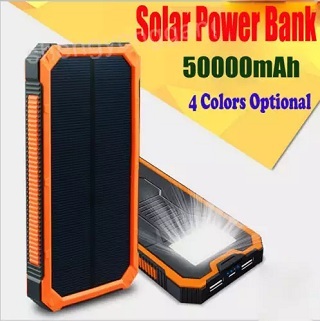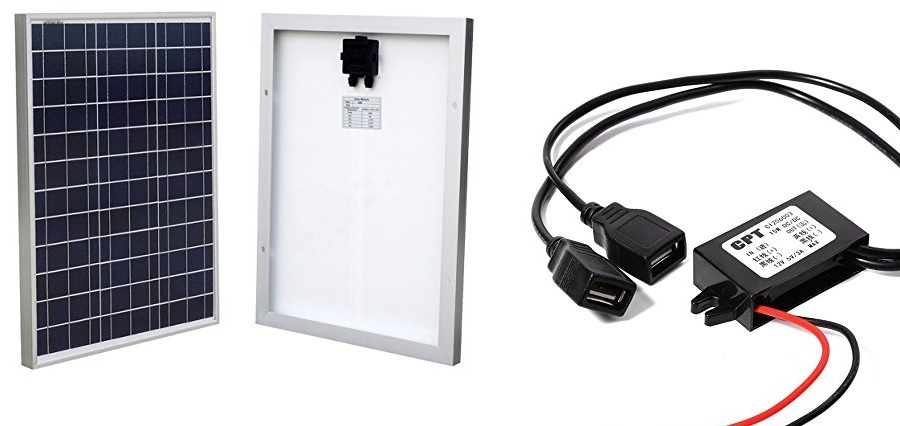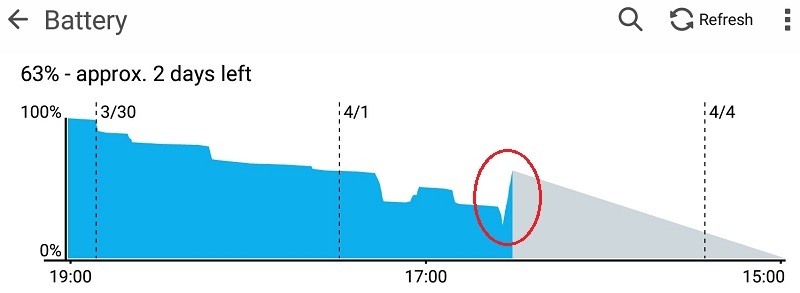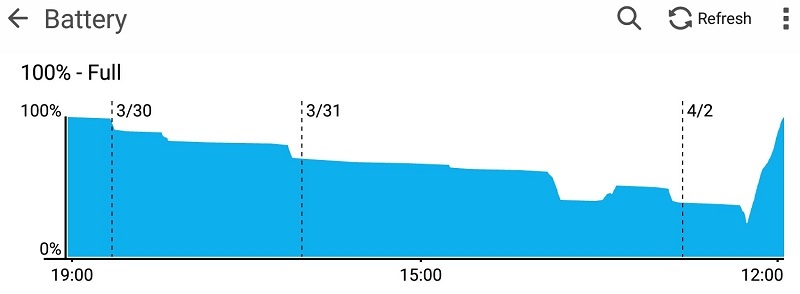Solar energy - in every backpack. Anker Solar Charger 21W charger overview
Spring came, the sun is shining more and more brightly, and after reading the next article about Elon Mask and his solar panels on the roof, I also wanted to join the "green energy".
Since I don’t have a separate roof in my personal access, it was decided to start small - to take a small solar panel to charge various gadgets, such as smartphones or tablets. As a bonus, get a standalone power supply for the hike:

Does this work, and test details under the cat.
When choosing a solar panel there are several important points.
')
First, for all solar panels, power is indicatedin Chinese watts for sunlight on a clear day at right angles. This means that the panel, declared for example, as 10W, will give much less per day on average. Therefore, it is necessary to have some power margin, preferably at least 2 times (for reference, the consumption of a modern smartphone via USB is approximately 5V * 2A = 10W).
Secondly, something like this (in the picture with eBay) looks like a 1.5W solar panel cell:

And that's just 1.5W! At the same time, online stores have on sale a lot of charges the size of a pack of cigarettes, such as these:

I hope it is now clear that taking no sense of them - judging by the size, at best their solar panel will not generate more watts (and the claimed 50000 mAh in such dimensions cause big questions). You can only charge one watt with a smart watch with a built-in 300 mAh battery. Unless of course you leave such a charge for a week, maybe she will charge her built-in battery, but neither at home nor on a hike, the point is exactly zero.
Well, in the third. There are chargers with built-in lithium battery, there is without it. In principle, both options have the right to exist. I decided to take it without a battery, because firstly, it is possible to charge gadgets directly, and secondly, since we are talking about green energy, the extra battery is the most redundant and non-eco-friendly part. And finally, the life of the solar panels is many years, and the built-in battery will be the weakest link.
From the point of view of the structural scheme, everything is simple: the solar panels are connected to a battery, to the output of which a DC-DC converter is connected, giving us the required 5V. Purely for home use, you can buy such a kit on eBay or amazon:

His review will be a little later, but for now let us return to our charge.
So, reviewing the different options for charging, I chose this:

(photo from the manufacturer's website)
In fact, there are many different ones, under different brands, and possibly made at the same plant, because Differences are often only in logos. Structurally, this is a set of solar batteries, in the right “pocket” there is a built-in converter with 2 USB ports:

(photo from the manufacturer's website)
There is no built-in battery, so obviously, the device is capable of delivering current only in the daytime. In other matters, if desired, the power bank can be purchased separately, their choice is now large.
A plus of the folding option is also the fact that when folded, the device is very compact, and it fits without problems in a bag or even more so in a backpack. There are also plated holes on the edges, which allows you to secure the device, such as a carbine. The mass of the device, according to the manufacturer, is 417 g, and the folded dimensions are 282 × 160 × 28 mm.
About the price. The price of the solar charger 21W ranges from $ 45 to $ 70 on eBay, depending on the logo and the greed of the seller, I did not find any fundamental difference in appearance. The price of the device on amazon.de is 50 Euro. In Russian stores, something a little different in another color was found for as many as 12,000, which, of course, is expensive.
The first day of testing was overcast. Obviously, the solar panel provides less energy, and the difference is very noticeable. In the morning, around 10 am, the charge simply did not work. On the smartphone, the charging icon lights up, but the current for the dc-dc converter is not enough and it turns off, the smartphone turns off the charge mode, the current decreases, the converter turns on again, the smartphone turns on the screen again indicating that the charge has started, and so on. In this mode, the constant blinking of the screen, the effect is even negative - the smartphone is discharged faster than if it was not connected at all. By the way, the Anker solar charger converter is declared as “intelligent” (PowerIQ). In real life, quite the opposite - if, in low light, the converter knew how to activate the “slow charging” mode (5V, 500mA), the smartphone would probably be charged. But most likely the whole “PowerIQ” is in a simple resistor between the D + / D-buses (you can read about resistors here ). In general, despite the stated "intelligence", it is better to look after the charge yourself, and if there is no sun at all, disconnect the device from it. However, back to testing. In the afternoon, from 13 to 16, there was more light, and in a couple of hours the charge level in the smartphone increased by about 10%, then it stopped growing completely. It can be assumed that in total for an overcast day from about 11 to 15 hours of the daylight hours, you can recharge the smartphone by about 15-20%. Of course, this is not enough, but for extreme tourists,to call home “mom, I'm still alive” in the evening is still better than nothing.
The second day of testing, quite successfully, turned out to be clear. Here the device works almost without problems. Since the morning the bright sun is shining, and the Asus Zenpad 8 "tablet, when charging from 8 to 10 in the morning, charged from 26 to 63%:

However, as the USB-wattmeter shows, during these 2 hours 1100mAh was given, but the charging current is only 450mA. Either the sun at 10 am is not so bright (although it looks like everything is ok), or the declared PowerIQ is not an IQ at all, or the 21W declared in the ad can only be given in the Himalayas under a clear sky at a height of several kilometers. But nevertheless, the device works, and it can be said for sure that it is quite realistic to charge them with both a smartphone and a tablet in a light day.
At 11 am, the charging current rose to 0.6A, but it’s still far from the maximum 2.0. By the way, when both the smartphone and the tablet were connected at the same time, the charging speed dropped, but still continued:

Finally, at 12:40, i.e. in about 4.5 hours, the tablet was fully charged from 26% to 100%.

Also in parallel, the smartphone was charging from 92% to 100%. But the charging current did not rise above 0.62A even at sunny noon, although the manufacturer promises "Fast Charging Technology" and "Output: DC 5V / 3A", but the truth is marked "with enough direct sunlight". Probably solar panels have nothing to do with it, let's leave it to marketers.
Another interesting point - the placement of the charger behind the glass in the apartment reduces the power output by about 20%. Apparently glass, although quite transparent in appearance, reflects a rather large part.
The good news is that chargers of this type really work, and can help out for example, on a camping trip, or even used at home. The bad news is that the characteristics are somewhat overestimated by marketers.
Practically, for charging a USB gadget you need 10W, and taking into account the specifics of solar panelsand Chinese marketing , the declared power can be easily multiplied by 2. That is, 20W is a minimum that can be used relatively comfortably. There are, for example, beautiful and expensive models of BioLite 5W, but it's really hard to imagine what they can charge. There are models for 40W, although there is already a question of convenience and dimensions, if we talk about tourism.
By the way, on hikes, so as not to mess with the wires while walking, it may be advisable to purchase a power bank for 10,000-200,000 mAh, which will be charged during the day. And in the evening you can connect to it a variety of devices for charging.
If you use the device at home, then the most effective will be just to put the panel on 50-100W, which I am going to do next time. To be continued.
Since I don’t have a separate roof in my personal access, it was decided to start small - to take a small solar panel to charge various gadgets, such as smartphones or tablets. As a bonus, get a standalone power supply for the hike:

Does this work, and test details under the cat.
What to choose
When choosing a solar panel there are several important points.
')
First, for all solar panels, power is indicated
Secondly, something like this (in the picture with eBay) looks like a 1.5W solar panel cell:

And that's just 1.5W! At the same time, online stores have on sale a lot of charges the size of a pack of cigarettes, such as these:

I hope it is now clear that taking no sense of them - judging by the size, at best their solar panel will not generate more watts (and the claimed 50000 mAh in such dimensions cause big questions). You can only charge one watt with a smart watch with a built-in 300 mAh battery. Unless of course you leave such a charge for a week, maybe she will charge her built-in battery, but neither at home nor on a hike, the point is exactly zero.
Well, in the third. There are chargers with built-in lithium battery, there is without it. In principle, both options have the right to exist. I decided to take it without a battery, because firstly, it is possible to charge gadgets directly, and secondly, since we are talking about green energy, the extra battery is the most redundant and non-eco-friendly part. And finally, the life of the solar panels is many years, and the built-in battery will be the weakest link.
From the point of view of the structural scheme, everything is simple: the solar panels are connected to a battery, to the output of which a DC-DC converter is connected, giving us the required 5V. Purely for home use, you can buy such a kit on eBay or amazon:

His review will be a little later, but for now let us return to our charge.
So, reviewing the different options for charging, I chose this:

(photo from the manufacturer's website)
In fact, there are many different ones, under different brands, and possibly made at the same plant, because Differences are often only in logos. Structurally, this is a set of solar batteries, in the right “pocket” there is a built-in converter with 2 USB ports:

(photo from the manufacturer's website)
There is no built-in battery, so obviously, the device is capable of delivering current only in the daytime. In other matters, if desired, the power bank can be purchased separately, their choice is now large.
A plus of the folding option is also the fact that when folded, the device is very compact, and it fits without problems in a bag or even more so in a backpack. There are also plated holes on the edges, which allows you to secure the device, such as a carbine. The mass of the device, according to the manufacturer, is 417 g, and the folded dimensions are 282 × 160 × 28 mm.
About the price. The price of the solar charger 21W ranges from $ 45 to $ 70 on eBay, depending on the logo and the greed of the seller, I did not find any fundamental difference in appearance. The price of the device on amazon.de is 50 Euro. In Russian stores, something a little different in another color was found for as many as 12,000, which, of course, is expensive.
Testing
The first day of testing was overcast. Obviously, the solar panel provides less energy, and the difference is very noticeable. In the morning, around 10 am, the charge simply did not work. On the smartphone, the charging icon lights up, but the current for the dc-dc converter is not enough and it turns off, the smartphone turns off the charge mode, the current decreases, the converter turns on again, the smartphone turns on the screen again indicating that the charge has started, and so on. In this mode, the constant blinking of the screen, the effect is even negative - the smartphone is discharged faster than if it was not connected at all. By the way, the Anker solar charger converter is declared as “intelligent” (PowerIQ). In real life, quite the opposite - if, in low light, the converter knew how to activate the “slow charging” mode (5V, 500mA), the smartphone would probably be charged. But most likely the whole “PowerIQ” is in a simple resistor between the D + / D-buses (you can read about resistors here ). In general, despite the stated "intelligence", it is better to look after the charge yourself, and if there is no sun at all, disconnect the device from it. However, back to testing. In the afternoon, from 13 to 16, there was more light, and in a couple of hours the charge level in the smartphone increased by about 10%, then it stopped growing completely. It can be assumed that in total for an overcast day from about 11 to 15 hours of the daylight hours, you can recharge the smartphone by about 15-20%. Of course, this is not enough, but for extreme tourists,
The second day of testing, quite successfully, turned out to be clear. Here the device works almost without problems. Since the morning the bright sun is shining, and the Asus Zenpad 8 "tablet, when charging from 8 to 10 in the morning, charged from 26 to 63%:

However, as the USB-wattmeter shows, during these 2 hours 1100mAh was given, but the charging current is only 450mA. Either the sun at 10 am is not so bright (although it looks like everything is ok), or the declared PowerIQ is not an IQ at all, or the 21W declared in the ad can only be given in the Himalayas under a clear sky at a height of several kilometers. But nevertheless, the device works, and it can be said for sure that it is quite realistic to charge them with both a smartphone and a tablet in a light day.
At 11 am, the charging current rose to 0.6A, but it’s still far from the maximum 2.0. By the way, when both the smartphone and the tablet were connected at the same time, the charging speed dropped, but still continued:

Finally, at 12:40, i.e. in about 4.5 hours, the tablet was fully charged from 26% to 100%.

Also in parallel, the smartphone was charging from 92% to 100%. But the charging current did not rise above 0.62A even at sunny noon, although the manufacturer promises "Fast Charging Technology" and "Output: DC 5V / 3A", but the truth is marked "with enough direct sunlight". Probably solar panels have nothing to do with it, let's leave it to marketers.
Another interesting point - the placement of the charger behind the glass in the apartment reduces the power output by about 20%. Apparently glass, although quite transparent in appearance, reflects a rather large part.
findings
The good news is that chargers of this type really work, and can help out for example, on a camping trip, or even used at home. The bad news is that the characteristics are somewhat overestimated by marketers.
Practically, for charging a USB gadget you need 10W, and taking into account the specifics of solar panels
By the way, on hikes, so as not to mess with the wires while walking, it may be advisable to purchase a power bank for 10,000-200,000 mAh, which will be charged during the day. And in the evening you can connect to it a variety of devices for charging.
If you use the device at home, then the most effective will be just to put the panel on 50-100W, which I am going to do next time. To be continued.
Source: https://habr.com/ru/post/402775/
All Articles